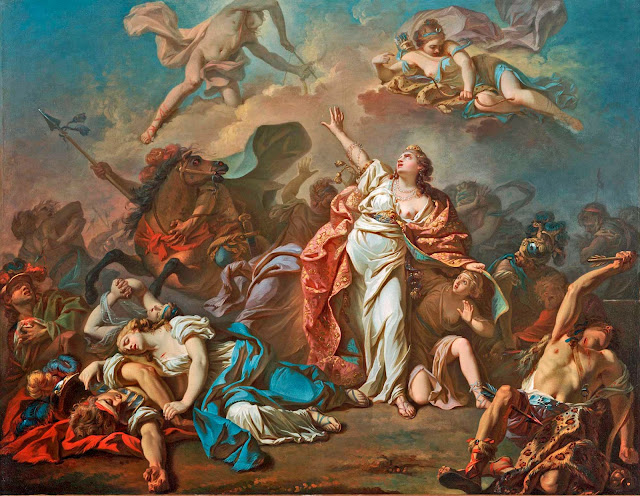NIOBE, sister of Pelops, had married Amphion, King of Thebes an borne him seven sons and seven daughters, of whom she was so inordinately proud that, one day, she disparaged Leto herself for having only two children: Apollo and Artemis. Manto, the prophetic daughter of Teiresias, overhearing this rash remark, advised the Theban women to placate Leto and her children at once: burning frank-incense and wreathing their hair with laurel branches. When the scent of incense was already floating in the air, Niobe appeared, followed by a throng of attendants and dressed in a splendid Phrygian robe, her long hair flowing loose. She interrupted the sacrifice and furiously asked why Leto, a woman of obscure parentage, with a mannish daughter and a womanish son, should be preferred to her, Niobe, grandchild of Zeus and Atlas, the dread of the Phrygians, and a queen of Cadmus’s royal house? Though fate or ill-luck might carry off two or three of her children, would she not still remain the richer?
b. Abandoning the sacrifice, the terrified Theban women tried to placate Leto with murmured prayers, but it was too late. She had already sent Apollo and Artemis, armed with bows, to punish Niobe’s presumption. Apollo found the boys hunting on Mount Cithaeron and shot them down one by one, sparing only Amyclas, who had wisely offered a propitiatory prayer to Leto. Artemis found the girls spinning in the palace and, with a quiverful of arrows, despatched all of them, except Meliboëa, who had followed Amyclas’s example. These two survivors hastened to build Leto a temple, though Meliboëa had turned so pale with fear that she was still nicknamed Chloris when she married Neleus some years later. But some say that none of Niobe’s children survived, and that her husband Amphion was also killed by Apollo.
c. For nine days and nine nights Niobe bewailed her dead, and found no one to bury them, because Zeus, taking Leto’s part, had turned all the Thebans into stone. On the tenth day, the Olympians themselves deigned to conduct the funeral. Niobe fled overseas to Mount Sipylus, the home of her father Tantalus, where Zeus, moved by pity, turned her into a statue which can still be seen weeping copiously in the early summer.
d. All men mourned for Amphion, deploring the extinction of his race, but none mourned for Niobe, except her equally proud brother Pelops.
1. The number of Niobe’s children is given by Homer as twelve and (according to various scholiasts) by Hesiod as twenty, by Herodotus as four, and by Sappho as eighteen; but the account followed by Euripides and Apollodorus, which makes the best sense, is that she had seven and seven daughters. Since Niobe, in the Theban version of the myth was a grand- daughter of the Titan Atlas and, in the Argive version, daughter or mother of Phoroneus, also described as a Titan, and Pelasgus; and could claim to be the first mortal woman violated by Zeus, the myth may concern the defeat of the seven Titans and Titanesses by the Olympians. If so, it records the suppression of the calendar system prevailing in Pelasgian Greece, Palestine, Syria, and North-western Europe; which was based on a month divided into four weeks of seven days, each ruled by one of the seven planetary bodies. Amphion and his twelve children, in Homer’s version of the myth, perhaps stand for the thirteen months of this calendar. Mount Sipylus may have been the last home in Asia Minor of the Titan’s cult, as Thebes was in Greece. The statue of Niobe is a crag of roughly human shape, which seems to weep when the sun’s arrows strike its winter cap of snow, and the likeness is reinforced by a Hittite Goddess mother carved in rock on the same mountain and dating from perhaps the late fifteenth century BC. ‘Niobe’ probably means snowy-the b representing the v in the Latin nivis, or the ph in the Greek nipha. One of her daughters is called Chiade by Hyginus: a word which makes no sense in Greek, unless it be a worn-down form of chionos niphades, ‘snow- flakes’.
g. Parthenius (Love Stories) gives a different account of Niobe’s punishment: by Leto’s contrivance, Niobe’s father fell incestuously love with her and, when she repulsed him, burned her children to death; her husband was then mangled by a wild boar, and she threw herself from a rock. This story, confirmed by the scholiast on Euripides’s Phoenician Women, is influenced by the myths of Cinyras, Smyrna and Adonis, and by the custom of burning children to the god Moloch.
c. For nine days and nine nights Niobe bewailed her dead, and found no one to bury them, because Zeus, taking Leto’s part, had turned all the Thebans into stone. On the tenth day, the Olympians themselves deigned to conduct the funeral. Niobe fled overseas to Mount Sipylus, the home of her father Tantalus, where Zeus, moved by pity, turned her into a statue which can still be seen weeping copiously in the early summer.
d. All men mourned for Amphion, deploring the extinction of his race, but none mourned for Niobe, except her equally proud brother Pelops.

Comments
Post a Comment